CATHEDRAL QUARTER TRAILS - FRIAR GATE (lower)
CATHEDRAL QUARTER – 5 FRIAR GATE (LOWER)
Stylish, independent shops, great places to eat and drink, valued professional services and impressive historical landmarks; Derby’s Cathedral Quarter has it all.
Looking up Friar Gate

Friar Gate is one of Derby’s most ancient streets and has retained many of its older buildings. Gell’s House is a fine example of a 17th-century townhouse. The Friary Hotel is built on part of the land once occupied by a Dominican Monastery, dating back to the 16th century.
The former settlement of Wardwick has had a church at its centre since at least 700AD. St Werburgh’s Church, on the corner of Cheapside and Friar Gate, has been rebuilt many times. The main problem that caused the instability was the frequency with which Markeaton Brook flooded. A problem not resolved until after the floods of 1932, when finally remedial action was taken. The oldest part of the church still in existence is the tower which was rebuilt in c1601.
St Werburgh’s Church

The Church, which closed for worship in the 1980s, later opened as a shopping gallery. But this venture was not a success and closed after a few years. It re-opened recently as a Chinese restaurant, but that too only lasted for a short period. A Trust cares for the tower and the old chancel.
St Werburgh’s tower was rebuilt in Gothic style between 1601/8. The chancel was built during the 1690s and retains much of its contemporary woodwork and furnishings. Including a superb iron font cover by Robert Bakewell and a beautiful reredos that was designed by Henry Huss. The register goes back to 1588. It was here that Doctor Johnson, the creator of the English Dictionary, married Elizabeth ‘Tetty’ Porter on 7 July 1735. Marks on the exterior walls are thought to have been made by cannonballs during the Civil War.
Former Derby Gas Light Company

The former Derby Gas, Light and Coke Company showrooms and offices used to operate from the premises in Friar Gate, are now used for other purposes. Built in 1889, the name of the company can still be seen on the wall of this fine Victorian building. The first public gas lamp was lit in Market Place, on 19 February 1821. Twenty years later, an Act of Parliament allowed Derby Gas Light and Coke Company to supply customers outside the Borough, leading to further expansion.
It was the first steel-framed building in Derby and is Grade II listed. In the 1960s the building was converted for retail use by British Gas with large plate-glass windows installed to make it look more like a modern shop.
Gell’s House
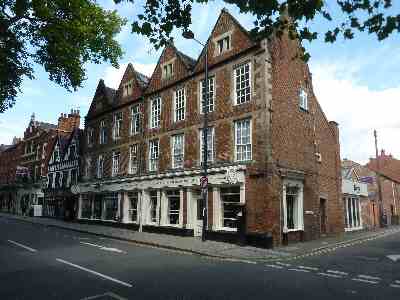
Gell’s House in Friar Gate is Derby’s finest surviving complete 17th-century townhouse. The four-storey gabled building was the Parliamentary headquarters during the English Civil war. It was probably built for Col Thomas Gell, the brother of Sir John Gell the notorious governor of Derby during the war. The Gell family lived at Hopton Hall for nearly 500 years and were the dominating influence in the area before the hall was sold in 1989.
Friary Hotel

The Friary Hotel was built on part of the grounds that once belonged to a Dominican Monastery. Here a large friary was erected with approximately 16 acres of parkland featuring fishponds, a chapel and other buildings.
In 1731, Samuel Crompton built a fine townhouse on the site where The Friary Hotel, a Grade II * listed building now stands. On his father’s death in 1725, Samuel had taken over the family’s banking business. This provided him with the capital to build the Friary. It was extended in 1760, 1875 and the 1950s.
The Boden family lived here from 1873 to 1922. Henry Boden and his wife Mary worked tirelessly for temperance, but several years after the death of her husband, she sold the house to the Whitaker family. Shortly afterwards they set about transforming it into a licensed hotel, much to the infuriation of Mary Boden.
Joseph Wright Centre
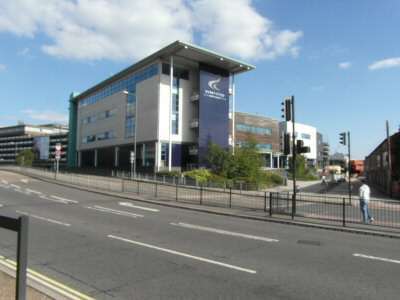
The £12m Joseph Wright Centre is part of Derby College and follows the merger of Mackworth, Broomfield and Wilmorton Colleges. The name originates from the internationally famous, local artist whose work in the mid to late 18th century was inspired by scientific and technological art forms. The building’s high-impact design produced by local architects is unique to Derby and covers 6,600 square meters of floor space over four storeys. As a result of the success of the centre over the first two years, the building has been extended to increase study and social space for students.
.
Deda

The Methodists moved from St Michael’s Lane to King Street in the 1800s and then to Chapel Street in 1929. Derby Dance now occupies the site and it is the only dedicated dance house in the East Midlands. Providing three dance studios, conference facilities, a café bar and two distinct performance spaces. The third dance floor was established in 2014. By incorporating part of the adjoining Leisure Centre.
Derby Dance was established at Derby Playhouse in 1991. Before funding from the National Lottery enabled it to move to new premises in 1997. After a further eleven years, the name changed to Déda. Dance and theatre performances take place at both the Déda, and the Cube The programme comprises comedy, music and literature. There is also a stylish café. Deda went into administration in 2024.
Flower Pot pub
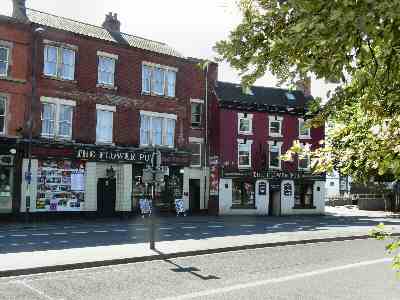
The premises occupied by the Flower Pot public house were built about 200 years ago, originally as a three-storey house. The pub’s name came as a result of a Flower Show held in nearby Cherry Street Drill Hall. During its earlier years, it acted as a coaching inn, where there was room for 10 horses and wagons in the stables. The unusual sign is listed in a review of curious pub signs in the Midlands.
The pub, having been extended into the property next door, is deceptively spacious inside. It is both a real ale and popular music venue, but the latter is kept separate to provide an area of comparative peace for drinkers.
St Alkmund’s Church plaque/Former Jurys Inn
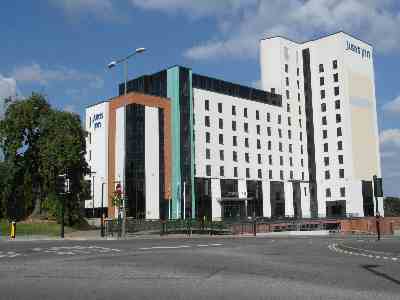
St Alkmund’s Church, built in 1846, on the site of an earlier church is claimed to have been originally founded early in the 9th century when St Alkmund’s remains were brought to Derby. There are only six churches in England dedicated to him. The Church was rebuilt by H I Stevens at £7,700 on the site of several earlier churches stretching back to the 9th century. It was demolished in 1967, to build the Inner Ring Road, now called St Alkmund’s Way. Joseph Wright the internationally famous artist was buried there. A plaque close to the entrance of the former Jurys Inn marks the site of the old church.
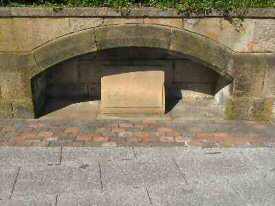
John Smith Clock Works
Number 27 Queen Street was built in the 1600s by Stephen Flamsteed, father of astronomer John Flamsteed who inherited it in 1688. It was fronted by Joseph Pickford in 1764 for his friend the philosopher and clockmaker John Whitehurst. Both artist Joseph Wright and astronomer royal John Flamsteed have lived there, which is commemorated by a blue plaque (John Flamsteed 1646-1719 and Joseph Wright 1734-1797)). Later it was divided, the left part becoming the Acorn Vaults, and the other side Smith’s Clock Works.

John Smith
John Smith, a former apprentice of John Whitehurst III had started his own business on Nuns’ Street six years before moving to Queen Street. The firm has maintained an excellent reputation for clock making and repair over the years and as a result, it has grown into one of the largest feature clockmakers in Europe. It was selected to make the clock for the Harmony Tower, which forms the centrepiece of a new time theme park in China. It is the largest clock in the World, just over twice the size of Big Ben. The firm now operates from a factory on Alfreton Road, Derby.
St Michael’s Church
The church was rebuilt in 1857-8 after the east gable collapsed during a service in 1856. John Erskine Clarke, who had just been appointed vicar, set about the task of organizing the reconstruction. He was a man of considerable energy and skill during his time at the church. Erskine started what was regarded as the first church parish magazine ever to be published.
Distressed at the violence he saw depicted in some children’s comics. He founded ‘The Prize’ a magazine for young children. This was successful as was the ‘Chatterbox’, a halfpenny weekly paper aimed at older children.
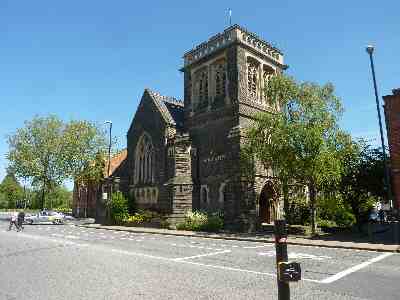
Church Closure
The church closed in the 1970s. It had been in existence from at least the 11th century, along the ancient north-south route. Following the closure, the church was sympathetically converted into architect’s offices by Derek Latham.
In the 17th and 18th centuries, the churchyard contained the cistern to George Sorocold’s ingenious system of providing drinking water to the townspeople of Derby. He had a very large pumping engine built by the River Derwent. This was mounted on a moveable frame that rose and fell as the river levels changed. Enabling water to be supplied regularly. Water from the cistern was then circulated by gravity around the town in pipes made out of elm.
Queen Street Leisure Centre and Swimming Baths
Queen Street Leisure Centre was a sports and leisure facility, where you could swim, use the gym and take part in group activities. Derby Borough Architect Herbert Aslin designed Queen Street Baths, which were opened to the public on 30 July 1932, by the Duke of Devonshire. The town’s first public baths had been opened nearly three-quarters of a century previously on Full Street and had been followed 15 years later by the Reginald Street Baths. A growing population and the lack of bathing facilities at many homes, as well as the desire to swim, resulted in considerable demand being built up for a modern complex. The facilities provide included two pools with modern water purification, steam heating and ventilation systems. In 1962, a teaching pool was added and other improvements have been made in recent years. A new pool has been built at Moorways.
